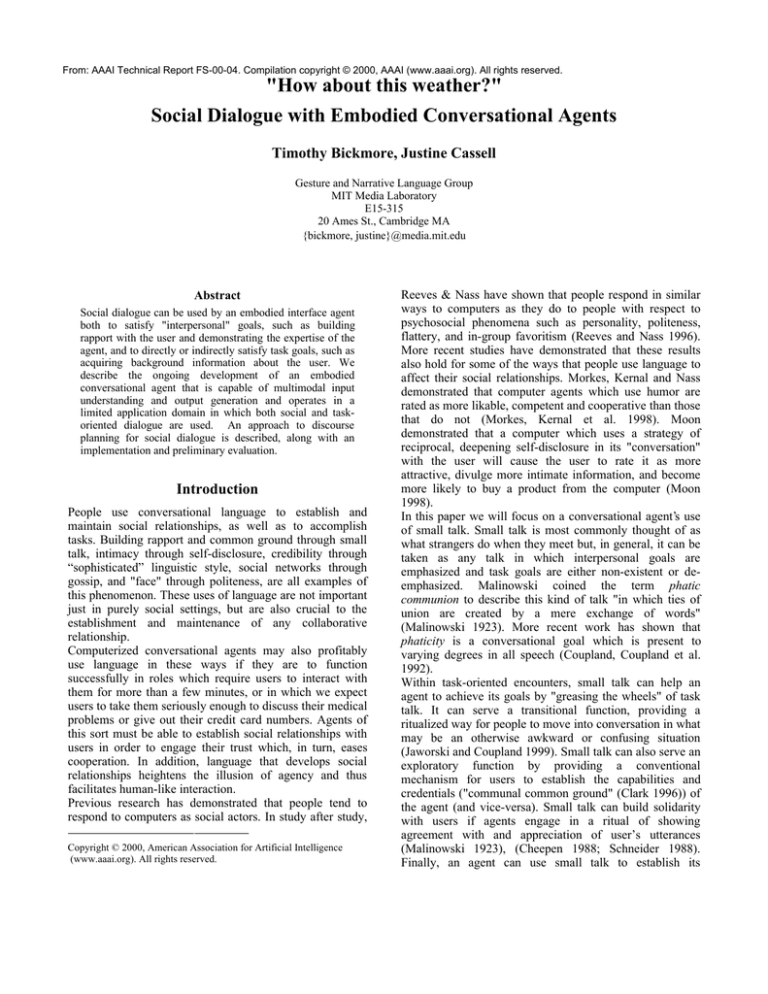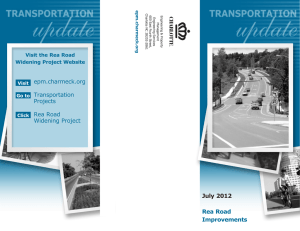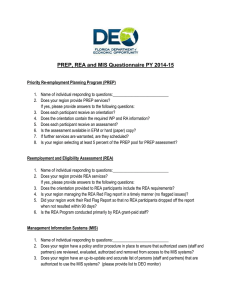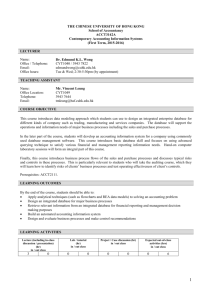
From: AAAI Technical Report FS-00-04. Compilation copyright © 2000, AAAI (www.aaai.org). All rights reserved.
"How about this weather?"
Social Dialogue with Embodied Conversational Agents
Timothy Bickmore, Justine Cassell
Gesture and Narrative Language Group
MIT Media Laboratory
E15-315
20 Ames St., Cambridge MA
{bickmore, justine}@media.mit.edu
Abstract
Social dialogue can be used by an embodied interface agent
both to satisfy "interpersonal" goals, such as building
rapport with the user and demonstrating the expertise of the
agent, and to directly or indirectly satisfy task goals, such as
acquiring background information about the user. We
describe the ongoing development of an embodied
conversational agent that is capable of multimodal input
understanding and output generation and operates in a
limited application domain in which both social and taskoriented dialogue are used. An approach to discourse
planning for social dialogue is described, along with an
implementation and preliminary evaluation.
Introduction
People use conversational language to establish and
maintain social relationships, as well as to accomplish
tasks. Building rapport and common ground through small
talk, intimacy through self-disclosure, credibility through
“sophisticated” linguistic style, social networks through
gossip, and "face" through politeness, are all examples of
this phenomenon. These uses of language are not important
just in purely social settings, but are also crucial to the
establishment and maintenance of any collaborative
relationship.
Computerized conversational agents may also profitably
use language in these ways if they are to function
successfully in roles which require users to interact with
them for more than a few minutes, or in which we expect
users to take them seriously enough to discuss their medical
problems or give out their credit card numbers. Agents of
this sort must be able to establish social relationships with
users in order to engage their trust which, in turn, eases
cooperation. In addition, language that develops social
relationships heightens the illusion of agency and thus
facilitates human-like interaction.
Previous research has demonstrated that people tend to
respond to computers as social actors. In study after study,
Copyright © 2000, American Association for Artificial Intelligence
(www.aaai.org). All rights reserved.
Reeves & Nass have shown that people respond in similar
ways to computers as they do to people with respect to
psychosocial phenomena such as personality, politeness,
flattery, and in-group favoritism (Reeves and Nass 1996).
More recent studies have demonstrated that these results
also hold for some of the ways that people use language to
affect their social relationships. Morkes, Kernal and Nass
demonstrated that computer agents which use humor are
rated as more likable, competent and cooperative than those
that do not (Morkes, Kernal et al. 1998). Moon
demonstrated that a computer which uses a strategy of
reciprocal, deepening self-disclosure in its "conversation"
with the user will cause the user to rate it as more
attractive, divulge more intimate information, and become
more likely to buy a product from the computer (Moon
1998).
In this paper we will focus on a conversational agent’s use
of small talk. Small talk is most commonly thought of as
what strangers do when they meet but, in general, it can be
taken as any talk in which interpersonal goals are
emphasized and task goals are either non-existent or deemphasized. Malinowski coined the term phatic
communion to describe this kind of talk "in which ties of
union are created by a mere exchange of words"
(Malinowski 1923). More recent work has shown that
phaticity is a conversational goal which is present to
varying degrees in all speech (Coupland, Coupland et al.
1992).
Within task-oriented encounters, small talk can help an
agent to achieve its goals by "greasing the wheels" of task
talk. It can serve a transitional function, providing a
ritualized way for people to move into conversation in what
may be an otherwise awkward or confusing situation
(Jaworski and Coupland 1999). Small talk can also serve an
exploratory function by providing a conventional
mechanism for users to establish the capabilities and
credentials ("communal common ground" (Clark 1996)) of
the agent (and vice-versa). Small talk can build solidarity
with users if agents engage in a ritual of showing
agreement with and appreciation of user’s utterances
(Malinowski 1923), (Cheepen 1988; Schneider 1988).
Finally, an agent can use small talk to establish its
expertise, by relating stories of past successful problemsolving behavior, and to obtain information about the user
that can be used indirectly to help achieve task goals (e.g.,
finding out that the user drives a minivan increases the
probability that s/he has children).
One domain in which small talk is especially important is
sales. Within sales, trust of the salesperson is of particular
importance, especially in major purchase decisions such as
real estate (Prus 1989). If the concept of trust is taken to be
a composite of the perceived benevolence and credibility of
an agent (Doney and Cannon 1997), then small talk should
contribute directly to building trust with the user, by
building rapport and establishing credibility and expertise.
REA: An Embodied Conversational RealEstate Agent
The goal of the Rea project at the MIT Media Lab is the
implementation and evaluation of an embodied, multimodal real-time conversational interface agent. Rea
implements the social, linguistic, and psychological
conventions of conversation to make interactions with a
computer as natural as face-to-face conversation with
another person. Rea differs from other dialogue systems,
and other interface agents in three ways:
• Rea has a human-like body, and uses her body in humanlike ways during the conversation. That is, she uses
eye gaze, body posture, hand gestures and facial
displays to organize and regulate the conversation as
well as to move the content of the conversation
forward.
underlying
approach
to
conversational
• The
understanding and generation in Rea is based on
discourse functions. Thus, each of the user’s inputs is
interpreted in terms of its conversational function and
responses are generated according to the desired
function to be fulfilled (Cassell, Bickmore et al. 1999).
• Rea is able to respond to visual, audio and speech cues
normally used in face to face conversation, such as
speech, shifts in gaze, gesture, and non-speech
feedback sounds. She is also able to generate these
cues, ensuring symmetry between input and output
modalities.
Rea has a fully articulated graphical body, can sense the
user passively through cameras and audio input, and is
capable of speech with intonation, facial display, and
gestural output. Rea is displayed on a large projection
screen, in front of which the user stands (see Figure 1).
Two cameras mounted on top of the screen track the user’s
head and hand positions, while a microphone captures
speech input. A single SGI Octane computer runs the
graphics and conversation engine of Rea, while several
other computers manage the speech recognition and
generation, and image processing.
Rea simultaneously processes the organization of
conversation and its content. When the user makes cues
typically associated with turn taking behavior such as
Figure 1. User interacting with Rea
gesturing, Rea allows herself to be interrupted, and then
takes the turn again when she is able. She is able to initiate
conversational repair when she misunderstands what the
user says, and can generate combined voice and gestural
output. An incremental natural language generation engine
based on (Stone, 1998), and extended to synthesize
redundant and complementary conversational hand
gestures, generates Rea’s responses.
REA is an acronym for "Real Estate Agent", and within
this domain we are currently focused on modeling the
initial interview with a prospective buyer. We selected real
estate sales specifically for the opportunity to explore a task
domain in which a significant amount of social dialog
normally occurs.
Discourse Planning for Social Dialog
Conversation to achieve social goals, such as small talk,
places many theoretically interesting demands on dialog
systems, a number of which have not been adequately – or
at all -- addressed by existent approaches to discourse
planning. A discourse planner for social dialog must be
able to manage and pursue multiple conversational goals
(Tracy and Coupland 1991), some of which may be
persistent or non-discrete. For example, in small talk where
there are apparently no task goals being pursued,
interlocutors are conscious of multiple goals related to
conversation initiation, regulation and maintenance
(Cegala, Waldro et al. 1988). In primarily task-oriented
interactions, speakers may also have several interpersonal
goals they are pursuing, such as developing a relationship
(e.g., befriending, earning trust) or establishing their
reputations or expertise. It is not sufficient that a discourse
planner work on one goal at a time, since a properly
selected utterance can, for example, satisfy a task goal by
providing information to the user while also advancing the
interpersonal goals of the agent. In addition, many goals,
such as intimacy or face goals (Coupland, Coupland et al.
1992) (Goffman 1983), are better represented by a model in
which degrees of satisfaction can be planned for, rather
than the discrete all-or-nothing goals typically addressed in
AI planners (Hanks 1994). The discourse planner must also
be very reactive, since the user’s responses cannot be
anticipated. The agent’s goals and plans may be
spontaneously achieved by the user (e.g., through
volunteered information) or invalidated (e.g., by the user
changing his/her mind) and the planner must be able to
immediately accommodate these changes.
The action selection problem (deciding what an
autonomous agent should do at any point in time) for
conversational agents includes choosing among behaviors
with an interactional function such as conversation
initiation, turn-taking, interruption, feedback, etc., and
behaviors with a propositional function such as conveying
information. Within computational linguistics, the
dominant
approach
to
determining
appropriate
propositional behaviors has been to use a speech-act-based
discourse planner, on top of a classical "static world"
planning mechanism like STRIPS (Fikes and Nilsson
1971), to determine the semantic content to be conveyed.
Once the content is determined, other processes are
typically used to map the semantic representations onto the
words the agent actually speaks. Other approaches have
included the use of rhetorical relations (Hovy 1988) and
domain-specific knowledge (Sibun 1992) to guide the
production of propositional output, but these are no more
adequate to planning for social dialog.
Given the novel requirements that social discourse places
upon a conversational agent’s action selection mechanism,
in particular the requirements for pursuing multiple, nondiscrete goals in a dynamic, real-time task domain, we have
moved away from static world discourse planning, and are
using an activation network-based approach based on Maes’
Do the Right Thing architecture (Maes 1989). This
architecture provides the capability to transition smoothly
from deliberative, planned behavior to opportunistic,
reactive behavior, and is able to pursue multiple, nondiscrete goals. In our implementation each node in the
network represents a joint project (Clark 1996) -- such as
telling a story, asking a question, or making a small talk
contribution -- whose execution can span multiple turns.
The selection of which joint project should be pursued by
Rea at any given time is a non-discrete function of the
following factors:
• Solidarity -- Rea continually assesses her solidarity with
the user, modeled as a scalar quantity.
Each
conversational topic has a pre-defined, pre-requisite
solidarity that must be achieved before Rea can
introduce the topic. Given this, the system can plan to
perform small talk in order to "grease the tracks" for
task talk, especially about sensitive topics like finance.
• Topic -- Rea keeps track of the current and past
conversational topics. Joint projects which stay within
topic (maintain topic coherence) are given preference
over those which do not. In addition, Rea can plan to
execute a sequence of joint projects which gradually
transition the topic from its current state to one that
Rea wants to talk about (e.g., from talk about the
weather, to talk about Boston weather, to talk about
Boston real estate).
• Relevance -- Rea maintains a list of topics that she thinks
the user knows about, and the discourse planner prefers
joint projects which involve topics in this list. The list
is initialized to things that anyone talking to Rea would
know about--such as the weather outside, Cambridge,
MIT, or the laboratory that Rea lives in.
• Task goals -- Rea has a list of prioritized goals to find
out about the user’s housing needs in the initial
interview. Joint projects which directly work towards
satisfying these goals (such as asking interview
questions) are preferred.
• Logical preconditions -- Joint projects have logical
preconditions (e.g., it makes no sense for Rea to ask
users what their major is until she has established that
they are students), and are not selected for execution
until all of their preconditions are satisfied. Following
Maes’ approach, joint projects which enable the
preconditions of other joint projects are preferred.
One advantage of the activation network approach is that
by simply adjusting a few gains we can make Rea more or
less coherent, more or less polite (attentive to solidarity
constraints), more or less task-oriented, or more or less
deliberative (vs. reactive) in her linguistic behavior.
Implementation
The discourse planner module for Rea currently manages
the interview phase with users, in which Rea determines
their housing needs. In this phase, the dialogue is entirely
Rea-initiated, and user responses are recognized via a
speaker-independent, grammar-based, continuous speech
recognizer (currently IBM ViaVoice). The active grammar
fragment is specified by the current joint project, and for
responses to many Rea small talk moves the content of
users’ speech is ignored; the fact that they responded at all
is enough to advance the dialogue.
Joint projects are specified by:
• Type -- e.g., small talk statement, small talk query, task
statement, task query
• Rea moves -- currently encoded as surface strings
• User moves -- speech recognition grammar specification
and whether a user response is required at all
• Conversational topics covered
• Logical preconditions and whether the joint project
contributes to a goal, as described above
At each step in the conversation in which Rea has the floor
(as tracked by a conversational state machine in Rea's
Reaction Module), the discourse planner is consulted for
the next joint project to initiate. At this point, activation
values are incrementally propagated through the network
(following (Maes 1989)) until a joint project is selected
whose preconditions are satisfied and whose activation
value is over a specified threshold.
Topic shifts are marked by discourse markers and beat
gestures. Discourse markers include "so" on the first small
talk to task talk transition, "anyway" on resumption of task
talk from small talk, and "you know" on transition to small
talk from task talk.
Within this framework, Rea decides to do small talk
whenever solidarity with the user needs to be increased
(e.g., before a task query can be asked), or the topic needs
to be moved incrementally to a desired topic and small talk
contributions exist which can facilitate this. The activation
energy from the user relevance condition described above
leads to Rea starting small talk with topics that are known
to be in the shared environment with the user (e.g., talk
about the weather or the lab).
Example Interactions
An interview between Rea and a user typically proceeds as
shown in the following dialogue (baseline case). (User
responses are only shown in positions in which they effect
the selection of subsequent joint projects.)
1. That microphone is terrible, I hate using those things.
2. Sorry about my voice, this is some engineer’s idea of
natural sounding.
3. Are you one of our sponsors? User: Yes
4. Were you at our last sponsor meetings?
5. I got so exhausted at the last sponsor meeting I think I
was starting to lose my voice by the end.
6. So, where would you like to live?
7. How many bedrooms do you need?
8. Do you need access to the subway?
9. Is one bath enough?
10. You know, Boston is certainly more expensive than it
used to be.
11. Anyway, what can you afford?
12. What kind of down payment can you make?
13. Let me see what I have available.
Example 1. "Normal Rea"
In this example, Rea opens with small talk moves regarding
things in her shared physical environment with the user (12). She then proceeds to small talk related to sponsors (after
establishing that the user is a sponsor). After a few turns,
enough solidarity has been established (simply by doing
small talk) that Rea can move into task talk (6-9).
However, before bringing up the topic of finance--a topic
that is potentially very face threatening for the user--Rea
decides that additional solidarity needs to be established,
and moves back into small talk (10). This small talk move
not only increases solidarity but shifts the topic to finance,
enabling Rea to then bring up the issue of how much the
user is able to afford (11-12).
If Rea’s adherence to solidarity preconditions is reduced, by
decreasing the contributions of these preconditions to the
activation of joint projects, this results in her being less
polite and empathetic, and more task goal oriented. If
everything else is held constant (relative to the baseline
example) the following dialogue is produced.
1. So, where would you like to live?
2. What can you afford?
3. What kind of down payment can you make?
4. How many bedrooms do you need?
5. Do you need access to the subway?
6. Is one bath enough?
7. Let me see what I have available.
Example 2. "Impolite Rea"
In this example, Rea does not perform any small talk and
sequences the task questions in strictly decreasing order of
priority.
As a final example, the importance of task goal satisfaction
can be reduced (relative to the baseline case) yielding the
following dialogue in which Rea rambles on at length
before getting down to business.
1. That microphone is terrible. I hate using those things.
2. Sorry about my voice. This is some engineer’s idea of
natural sounding.
3. Are you tired of demos yet?
4. Are you one of our sponsors? User: Yes
5. Were you at our last sponsor meetings?
6. I got so exhausted at the last sponsor meeting. I think I
was starting to lose my voice by the end.
7. I have lived in Boston all my life. Come to think of it, I
have lived inside this room all of my life. It is so
depressing.
8. How about this weather?
9. I think winters in Boston are awful
10. Boston is certainly more expensive than it used to be.
11. So, what can you afford?
12. What kind of down payment can you make?
13. You know, I keep showing the researchers here the
same houses, over and over again. Maybe one day I
will get lucky.
14. Have you been in the Media Lab before?
15. It is pretty cool do you think?
16. They are doing some crazy things in here.
17. Do you know that the Media Lab is going to expand
into another building. Things are really going well for
the researchers here.
18. I really love it here at M I T. Do you?
19. It is pretty intense, do you think?
20. I have shown houses to lots of students and faculty
from M I T. But I always enjoy talking to them.
21. Anyway, where would you like to live?
22. How many bedrooms do you need?
23. Do you need access to the subway?
24. Is one bath enough?
25. Let me see what I have available.
Example 3. "Chatty Rea"
When task goals become less important, topic coherence
and other source of activation energy become the primary
factors in deciding what Rea says next. In this example, by
the time Rea has transitioned into the topic of finance
enough solidarity has been established that she can
immediately ask the user how much they can afford (1112).
Evaluation
We are currently conducting an experiment to assess the
efficacy of small talk in real estate interviews with Rea,
and its effect on the user’s perception of and trust in Rea.
Subjects are interviewed by Rea about their housing needs,
shown two "virtual" apartments, and then asked to fill out a
questionnaire, which includes questions about how much
rent they would be willing to pay for one of the apartments,
attitudinal measures of perceived likability, competence,
and intelligence of Rea, and a standard measure of trust
(Wheeless and Grotz 1977). This is a between-subjects
experiment with two conditions: TASK - Rea does not do
any small talk; and NATURAL - Rea does a "natural"
amount of small talk representative of the output of the
discourse planner described above. To avoid possibly
confounding conditions, no humorous or self-disclosing
small talk utterances are used, and Rea is controlled using a
wizard-of-oz configuration so that variations in speech
recognition accuracy do not adversely affect the results. A
pilot study indicated that users trust Rea more and like her
more in the NATURAL condition (example given above),
but significant results await completion of the full study.
Conclusion
Social intelligence includes knowledge of when and how to
use language to achieve social goals. This knowledge is
crucial for our computational agents if they are to be as
effective as people, and if we want people to be able to use
our agents easily, efficiently, and cooperatively. As
embodied conversational agents become ubiquitous, the
ability for them to establish and maintain social
relationships with us will become increasingly important.
It is possible to specify social and task goals in such a way
that small talk can be generated to achieve social goals such
as decreased interpersonal distance, which in turn achieves
task goals such as achieving a sale.
References
Cassell, J., T. Bickmore, et al. (1999). Embodiment in
Conversational Interfaces: Rea. CHI 99, Pittsburgh, PA.
Cegala, D., V. Waldro, et al. (1988). A study of interactants’
thoughts and feelings during conversation. Ninth Annual
Conference on Discourse Analysis, Philadelphia, PA.
Cheepen, C. (1988). The Predictability of Informal Conversation.
New York, Pinter.
Clark, H. H. (1996). Using Language. Cambridge, Cambridge
University Press.
Coupland, J., N. Coupland, et al. (1992). “"How are you?":
Negotiating phatic communion.” Language in Society 21: 207230.
Doney, P. and J. Cannon (1997). “An Examination of the Nature
of Trust in Buyer-Seller Relationships.” Journal of Marketing 61:
35-51.
Fikes, R. and N. Nilsson (1971). “STRIPS: A new approach to the
application of theorem proving to problem solving.” Artificial
Intelligence 5(2): 189-208.
Goffman, E. (1983). Forms of Talk. Philadelphia, PA, University
of Pennsylvania Publications.
Hanks, S. (1994). Discourse Planning: Technical Challenges for
the Planning Community. AAAI Workshop on Planning for InterAgent Communication.
Hovy, E. H. (1988). Planning Coherent Multisentential Text.
ACL, Buffalo, NY.
Jaworski, A. and N. Coupland (1999). The Discourse Reader.
London, Routledge.
Maes, P. (1989). “How to do the right thing.” Connection Science
Journal 1(3).
Malinowski, B. (1923). The problem of meaning in primitive
languages. The Meaning of Meaning. C. K. Ogden and I. A.
Richards, Routledge & Kegan Paul.
Moon, Y. (1998). Intimate self-disclosure exhanges: Using
computers to build reciprocal relationships with consumers.
Cambridge, MA, Harvard Business School.
Morkes, J., H. Kernal, et al. (1998). Humor in Task-Oriented
Computer-Mediated Communication and Human-Computer
Interaction. CHI 98.
Prus, R. (1989). Making Sales: Influence as Interpersonal
Accomplishment. Newbury Park, CA, Sage.
Reeves, B. and C. Nass (1996). The Media Equation: how people
treat computers, televisions and new media like real people and
places. Cambridge, Cambridge University Press.
Schneider, K. P. (1988). Small Talk: Analysing Phatic Discourse.
Marburg, Hitzeroth.
Sibun, P. (1992). “Generating Text Without Trees.”
Computational Intelligence: Special Issue on Natural Language
Generation 8(1): 102-122.
Tracy, K. and N. Coupland (1991). Multiple goals in discourse:
An overview of issues. Multiple goals in discourse. K. Tracy and
N. Coupland. Clevedon, Multilingual Matters: 1-13.
Wheeless, L. and J. Grotz (1977). “The Measurement of Trust and
Its Relationship to Self-Disclosure.” Human Communication
Research 3(3): 250-257.








